UniSA Report: IT Procurement Management and Vendor Management
VerifiedAdded on 2023/06/11
|8
|2536
|348
Report
AI Summary
This report discusses IT procurement management and vendor management, emphasizing the importance of selecting the right procurement approach based on project requirements and organizational background. It details the components of an enforceable contract, including offers, acceptance, mutual agreements, and consideration, highlighting the need for legal advice and thorough analysis. The report also explores the different components of an offer, the difference between independent and dependent demand, hidden costs of outsourcing, and the relationship between Total Quality Management (TQM) and IT procurement. Furthermore, it examines psychological factors affecting bargaining, conflicts between pure economics and IT procurement practices, key procurement considerations for Cloud SaaS offerings, and the inclusion of the Critical Path within a service's Statement of Work (SOW). Desklib provides this document, along with a wealth of other study resources, to aid students in their academic pursuits.
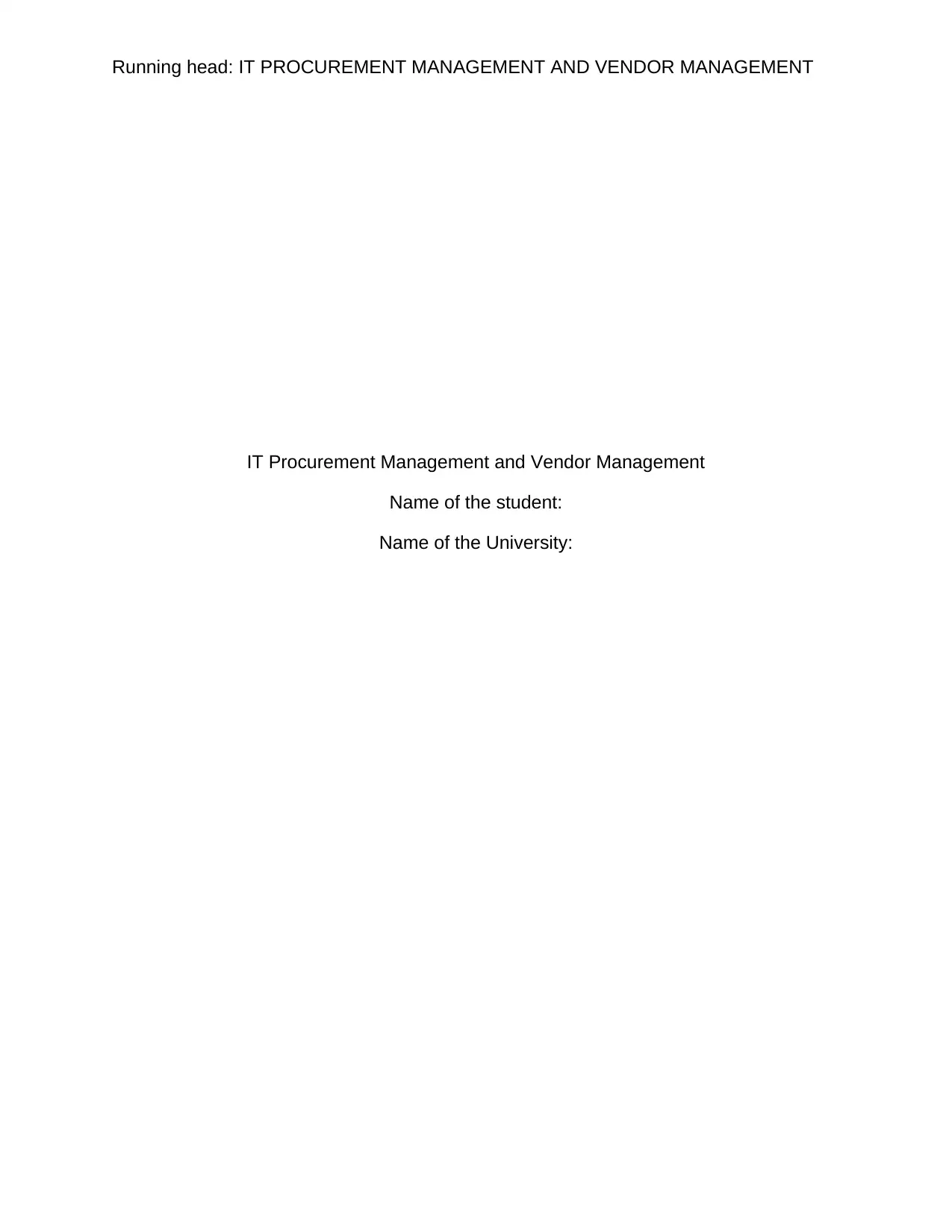
Running head: IT PROCUREMENT MANAGEMENT AND VENDOR MANAGEMENT
IT Procurement Management and Vendor Management
Name of the student:
Name of the University:
IT Procurement Management and Vendor Management
Name of the student:
Name of the University:
Paraphrase This Document
Need a fresh take? Get an instant paraphrase of this document with our AI Paraphraser
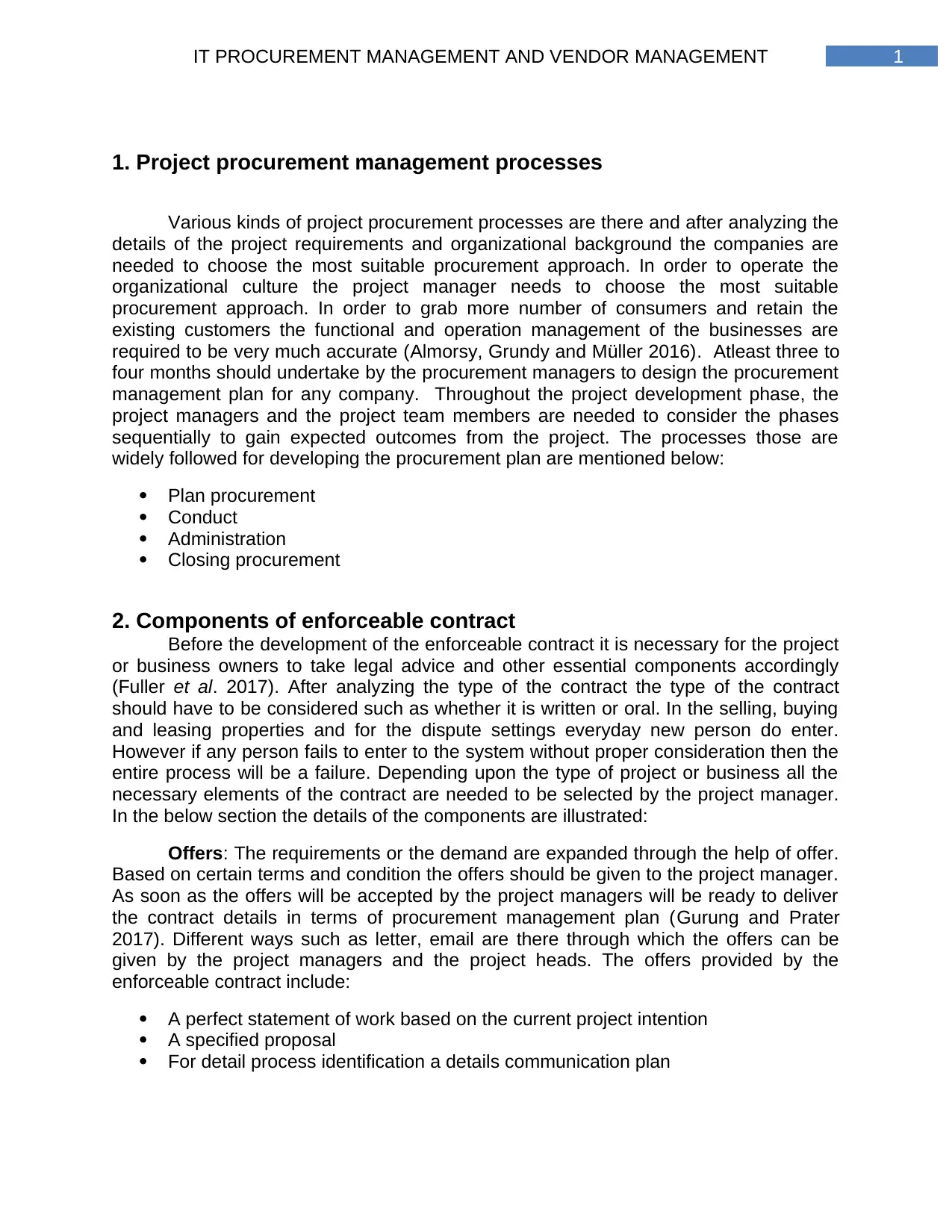
1IT PROCUREMENT MANAGEMENT AND VENDOR MANAGEMENT
1. Project procurement management processes
Various kinds of project procurement processes are there and after analyzing the
details of the project requirements and organizational background the companies are
needed to choose the most suitable procurement approach. In order to operate the
organizational culture the project manager needs to choose the most suitable
procurement approach. In order to grab more number of consumers and retain the
existing customers the functional and operation management of the businesses are
required to be very much accurate (Almorsy, Grundy and Müller 2016). Atleast three to
four months should undertake by the procurement managers to design the procurement
management plan for any company. Throughout the project development phase, the
project managers and the project team members are needed to consider the phases
sequentially to gain expected outcomes from the project. The processes those are
widely followed for developing the procurement plan are mentioned below:
Plan procurement
Conduct
Administration
Closing procurement
2. Components of enforceable contract
Before the development of the enforceable contract it is necessary for the project
or business owners to take legal advice and other essential components accordingly
(Fuller et al. 2017). After analyzing the type of the contract the type of the contract
should have to be considered such as whether it is written or oral. In the selling, buying
and leasing properties and for the dispute settings everyday new person do enter.
However if any person fails to enter to the system without proper consideration then the
entire process will be a failure. Depending upon the type of project or business all the
necessary elements of the contract are needed to be selected by the project manager.
In the below section the details of the components are illustrated:
Offers: The requirements or the demand are expanded through the help of offer.
Based on certain terms and condition the offers should be given to the project manager.
As soon as the offers will be accepted by the project managers will be ready to deliver
the contract details in terms of procurement management plan (Gurung and Prater
2017). Different ways such as letter, email are there through which the offers can be
given by the project managers and the project heads. The offers provided by the
enforceable contract include:
A perfect statement of work based on the current project intention
A specified proposal
For detail process identification a details communication plan
1. Project procurement management processes
Various kinds of project procurement processes are there and after analyzing the
details of the project requirements and organizational background the companies are
needed to choose the most suitable procurement approach. In order to operate the
organizational culture the project manager needs to choose the most suitable
procurement approach. In order to grab more number of consumers and retain the
existing customers the functional and operation management of the businesses are
required to be very much accurate (Almorsy, Grundy and Müller 2016). Atleast three to
four months should undertake by the procurement managers to design the procurement
management plan for any company. Throughout the project development phase, the
project managers and the project team members are needed to consider the phases
sequentially to gain expected outcomes from the project. The processes those are
widely followed for developing the procurement plan are mentioned below:
Plan procurement
Conduct
Administration
Closing procurement
2. Components of enforceable contract
Before the development of the enforceable contract it is necessary for the project
or business owners to take legal advice and other essential components accordingly
(Fuller et al. 2017). After analyzing the type of the contract the type of the contract
should have to be considered such as whether it is written or oral. In the selling, buying
and leasing properties and for the dispute settings everyday new person do enter.
However if any person fails to enter to the system without proper consideration then the
entire process will be a failure. Depending upon the type of project or business all the
necessary elements of the contract are needed to be selected by the project manager.
In the below section the details of the components are illustrated:
Offers: The requirements or the demand are expanded through the help of offer.
Based on certain terms and condition the offers should be given to the project manager.
As soon as the offers will be accepted by the project managers will be ready to deliver
the contract details in terms of procurement management plan (Gurung and Prater
2017). Different ways such as letter, email are there through which the offers can be
given by the project managers and the project heads. The offers provided by the
enforceable contract include:
A perfect statement of work based on the current project intention
A specified proposal
For detail process identification a details communication plan
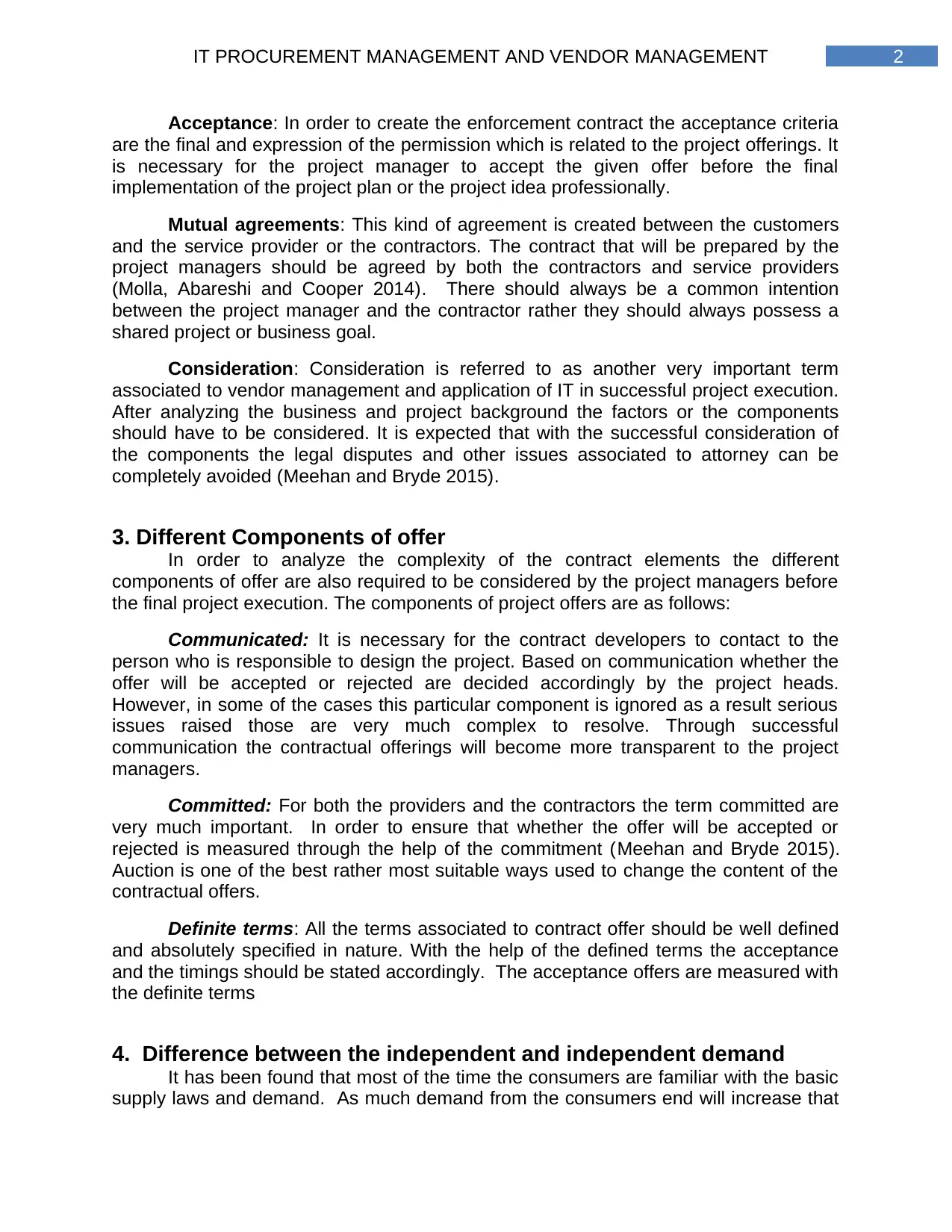
2IT PROCUREMENT MANAGEMENT AND VENDOR MANAGEMENT
Acceptance: In order to create the enforcement contract the acceptance criteria
are the final and expression of the permission which is related to the project offerings. It
is necessary for the project manager to accept the given offer before the final
implementation of the project plan or the project idea professionally.
Mutual agreements: This kind of agreement is created between the customers
and the service provider or the contractors. The contract that will be prepared by the
project managers should be agreed by both the contractors and service providers
(Molla, Abareshi and Cooper 2014). There should always be a common intention
between the project manager and the contractor rather they should always possess a
shared project or business goal.
Consideration: Consideration is referred to as another very important term
associated to vendor management and application of IT in successful project execution.
After analyzing the business and project background the factors or the components
should have to be considered. It is expected that with the successful consideration of
the components the legal disputes and other issues associated to attorney can be
completely avoided (Meehan and Bryde 2015).
3. Different Components of offer
In order to analyze the complexity of the contract elements the different
components of offer are also required to be considered by the project managers before
the final project execution. The components of project offers are as follows:
Communicated: It is necessary for the contract developers to contact to the
person who is responsible to design the project. Based on communication whether the
offer will be accepted or rejected are decided accordingly by the project heads.
However, in some of the cases this particular component is ignored as a result serious
issues raised those are very much complex to resolve. Through successful
communication the contractual offerings will become more transparent to the project
managers.
Committed: For both the providers and the contractors the term committed are
very much important. In order to ensure that whether the offer will be accepted or
rejected is measured through the help of the commitment (Meehan and Bryde 2015).
Auction is one of the best rather most suitable ways used to change the content of the
contractual offers.
Definite terms: All the terms associated to contract offer should be well defined
and absolutely specified in nature. With the help of the defined terms the acceptance
and the timings should be stated accordingly. The acceptance offers are measured with
the definite terms
4. Difference between the independent and independent demand
It has been found that most of the time the consumers are familiar with the basic
supply laws and demand. As much demand from the consumers end will increase that
Acceptance: In order to create the enforcement contract the acceptance criteria
are the final and expression of the permission which is related to the project offerings. It
is necessary for the project manager to accept the given offer before the final
implementation of the project plan or the project idea professionally.
Mutual agreements: This kind of agreement is created between the customers
and the service provider or the contractors. The contract that will be prepared by the
project managers should be agreed by both the contractors and service providers
(Molla, Abareshi and Cooper 2014). There should always be a common intention
between the project manager and the contractor rather they should always possess a
shared project or business goal.
Consideration: Consideration is referred to as another very important term
associated to vendor management and application of IT in successful project execution.
After analyzing the business and project background the factors or the components
should have to be considered. It is expected that with the successful consideration of
the components the legal disputes and other issues associated to attorney can be
completely avoided (Meehan and Bryde 2015).
3. Different Components of offer
In order to analyze the complexity of the contract elements the different
components of offer are also required to be considered by the project managers before
the final project execution. The components of project offers are as follows:
Communicated: It is necessary for the contract developers to contact to the
person who is responsible to design the project. Based on communication whether the
offer will be accepted or rejected are decided accordingly by the project heads.
However, in some of the cases this particular component is ignored as a result serious
issues raised those are very much complex to resolve. Through successful
communication the contractual offerings will become more transparent to the project
managers.
Committed: For both the providers and the contractors the term committed are
very much important. In order to ensure that whether the offer will be accepted or
rejected is measured through the help of the commitment (Meehan and Bryde 2015).
Auction is one of the best rather most suitable ways used to change the content of the
contractual offers.
Definite terms: All the terms associated to contract offer should be well defined
and absolutely specified in nature. With the help of the defined terms the acceptance
and the timings should be stated accordingly. The acceptance offers are measured with
the definite terms
4. Difference between the independent and independent demand
It has been found that most of the time the consumers are familiar with the basic
supply laws and demand. As much demand from the consumers end will increase that
⊘ This is a preview!⊘
Do you want full access?
Subscribe today to unlock all pages.

Trusted by 1+ million students worldwide
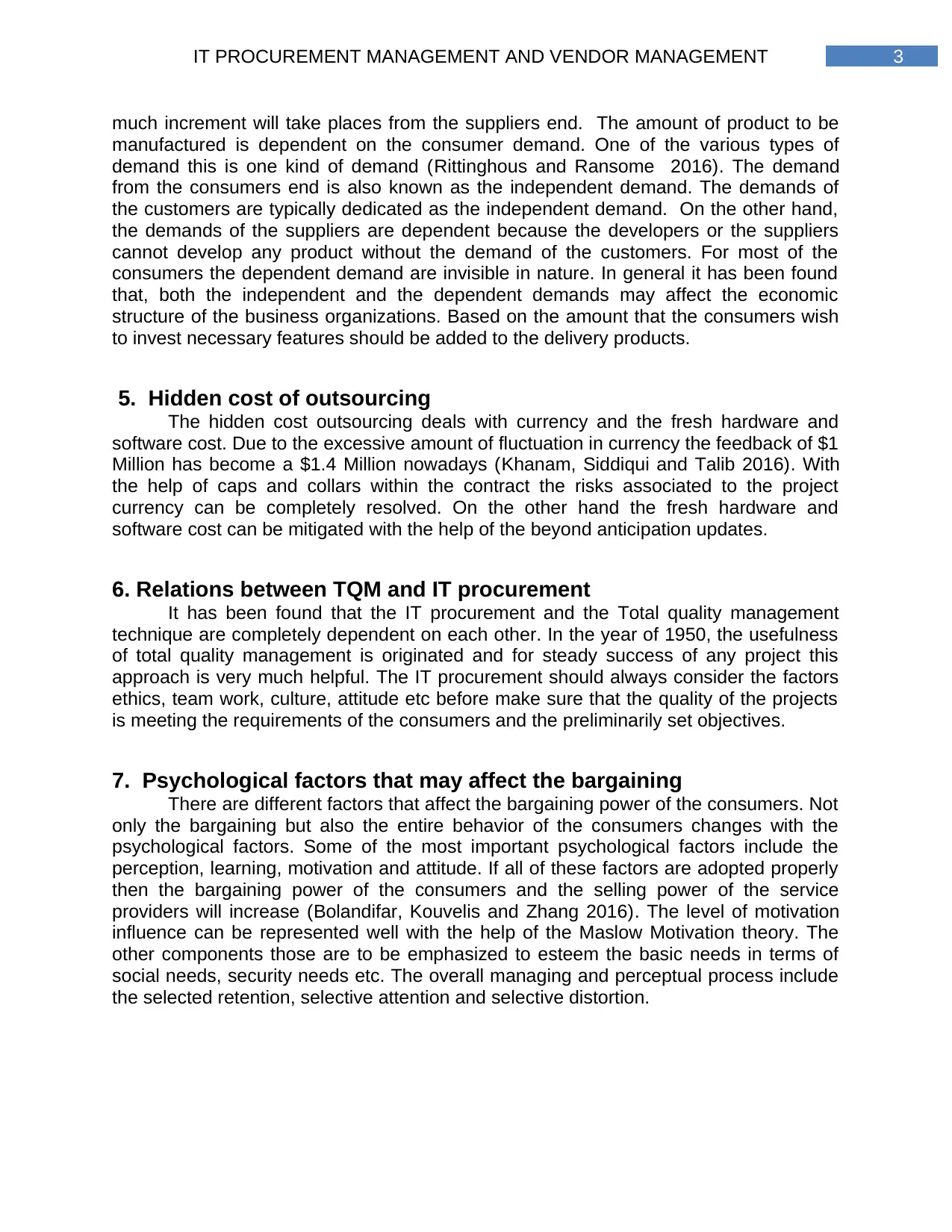
3IT PROCUREMENT MANAGEMENT AND VENDOR MANAGEMENT
much increment will take places from the suppliers end. The amount of product to be
manufactured is dependent on the consumer demand. One of the various types of
demand this is one kind of demand (Rittinghous and Ransome 2016). The demand
from the consumers end is also known as the independent demand. The demands of
the customers are typically dedicated as the independent demand. On the other hand,
the demands of the suppliers are dependent because the developers or the suppliers
cannot develop any product without the demand of the customers. For most of the
consumers the dependent demand are invisible in nature. In general it has been found
that, both the independent and the dependent demands may affect the economic
structure of the business organizations. Based on the amount that the consumers wish
to invest necessary features should be added to the delivery products.
5. Hidden cost of outsourcing
The hidden cost outsourcing deals with currency and the fresh hardware and
software cost. Due to the excessive amount of fluctuation in currency the feedback of $1
Million has become a $1.4 Million nowadays (Khanam, Siddiqui and Talib 2016). With
the help of caps and collars within the contract the risks associated to the project
currency can be completely resolved. On the other hand the fresh hardware and
software cost can be mitigated with the help of the beyond anticipation updates.
6. Relations between TQM and IT procurement
It has been found that the IT procurement and the Total quality management
technique are completely dependent on each other. In the year of 1950, the usefulness
of total quality management is originated and for steady success of any project this
approach is very much helpful. The IT procurement should always consider the factors
ethics, team work, culture, attitude etc before make sure that the quality of the projects
is meeting the requirements of the consumers and the preliminarily set objectives.
7. Psychological factors that may affect the bargaining
There are different factors that affect the bargaining power of the consumers. Not
only the bargaining but also the entire behavior of the consumers changes with the
psychological factors. Some of the most important psychological factors include the
perception, learning, motivation and attitude. If all of these factors are adopted properly
then the bargaining power of the consumers and the selling power of the service
providers will increase (Bolandifar, Kouvelis and Zhang 2016). The level of motivation
influence can be represented well with the help of the Maslow Motivation theory. The
other components those are to be emphasized to esteem the basic needs in terms of
social needs, security needs etc. The overall managing and perceptual process include
the selected retention, selective attention and selective distortion.
much increment will take places from the suppliers end. The amount of product to be
manufactured is dependent on the consumer demand. One of the various types of
demand this is one kind of demand (Rittinghous and Ransome 2016). The demand
from the consumers end is also known as the independent demand. The demands of
the customers are typically dedicated as the independent demand. On the other hand,
the demands of the suppliers are dependent because the developers or the suppliers
cannot develop any product without the demand of the customers. For most of the
consumers the dependent demand are invisible in nature. In general it has been found
that, both the independent and the dependent demands may affect the economic
structure of the business organizations. Based on the amount that the consumers wish
to invest necessary features should be added to the delivery products.
5. Hidden cost of outsourcing
The hidden cost outsourcing deals with currency and the fresh hardware and
software cost. Due to the excessive amount of fluctuation in currency the feedback of $1
Million has become a $1.4 Million nowadays (Khanam, Siddiqui and Talib 2016). With
the help of caps and collars within the contract the risks associated to the project
currency can be completely resolved. On the other hand the fresh hardware and
software cost can be mitigated with the help of the beyond anticipation updates.
6. Relations between TQM and IT procurement
It has been found that the IT procurement and the Total quality management
technique are completely dependent on each other. In the year of 1950, the usefulness
of total quality management is originated and for steady success of any project this
approach is very much helpful. The IT procurement should always consider the factors
ethics, team work, culture, attitude etc before make sure that the quality of the projects
is meeting the requirements of the consumers and the preliminarily set objectives.
7. Psychological factors that may affect the bargaining
There are different factors that affect the bargaining power of the consumers. Not
only the bargaining but also the entire behavior of the consumers changes with the
psychological factors. Some of the most important psychological factors include the
perception, learning, motivation and attitude. If all of these factors are adopted properly
then the bargaining power of the consumers and the selling power of the service
providers will increase (Bolandifar, Kouvelis and Zhang 2016). The level of motivation
influence can be represented well with the help of the Maslow Motivation theory. The
other components those are to be emphasized to esteem the basic needs in terms of
social needs, security needs etc. The overall managing and perceptual process include
the selected retention, selective attention and selective distortion.
Paraphrase This Document
Need a fresh take? Get an instant paraphrase of this document with our AI Paraphraser
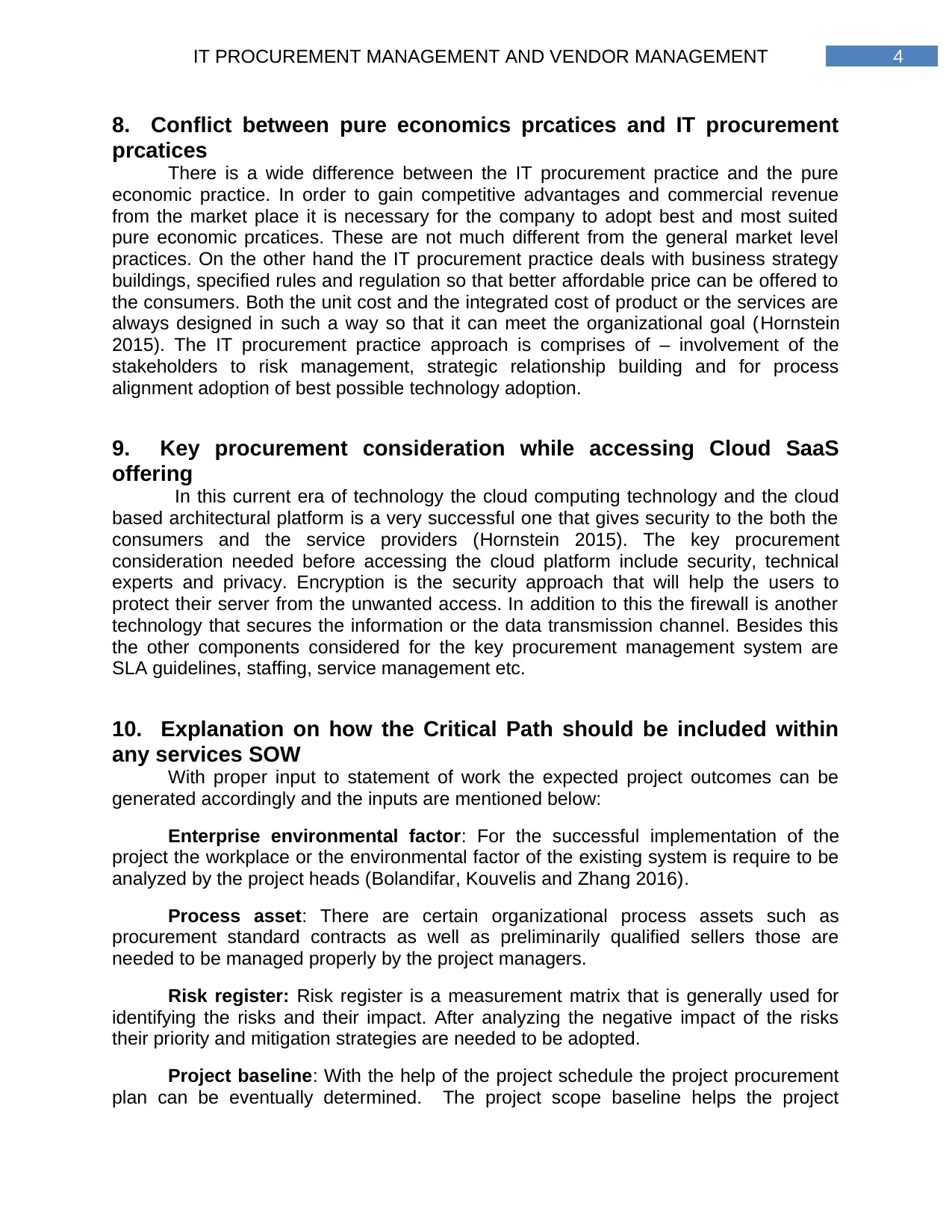
4IT PROCUREMENT MANAGEMENT AND VENDOR MANAGEMENT
8. Conflict between pure economics prcatices and IT procurement
prcatices
There is a wide difference between the IT procurement practice and the pure
economic practice. In order to gain competitive advantages and commercial revenue
from the market place it is necessary for the company to adopt best and most suited
pure economic prcatices. These are not much different from the general market level
practices. On the other hand the IT procurement practice deals with business strategy
buildings, specified rules and regulation so that better affordable price can be offered to
the consumers. Both the unit cost and the integrated cost of product or the services are
always designed in such a way so that it can meet the organizational goal (Hornstein
2015). The IT procurement practice approach is comprises of – involvement of the
stakeholders to risk management, strategic relationship building and for process
alignment adoption of best possible technology adoption.
9. Key procurement consideration while accessing Cloud SaaS
offering
In this current era of technology the cloud computing technology and the cloud
based architectural platform is a very successful one that gives security to the both the
consumers and the service providers (Hornstein 2015). The key procurement
consideration needed before accessing the cloud platform include security, technical
experts and privacy. Encryption is the security approach that will help the users to
protect their server from the unwanted access. In addition to this the firewall is another
technology that secures the information or the data transmission channel. Besides this
the other components considered for the key procurement management system are
SLA guidelines, staffing, service management etc.
10. Explanation on how the Critical Path should be included within
any services SOW
With proper input to statement of work the expected project outcomes can be
generated accordingly and the inputs are mentioned below:
Enterprise environmental factor: For the successful implementation of the
project the workplace or the environmental factor of the existing system is require to be
analyzed by the project heads (Bolandifar, Kouvelis and Zhang 2016).
Process asset: There are certain organizational process assets such as
procurement standard contracts as well as preliminarily qualified sellers those are
needed to be managed properly by the project managers.
Risk register: Risk register is a measurement matrix that is generally used for
identifying the risks and their impact. After analyzing the negative impact of the risks
their priority and mitigation strategies are needed to be adopted.
Project baseline: With the help of the project schedule the project procurement
plan can be eventually determined. The project scope baseline helps the project
8. Conflict between pure economics prcatices and IT procurement
prcatices
There is a wide difference between the IT procurement practice and the pure
economic practice. In order to gain competitive advantages and commercial revenue
from the market place it is necessary for the company to adopt best and most suited
pure economic prcatices. These are not much different from the general market level
practices. On the other hand the IT procurement practice deals with business strategy
buildings, specified rules and regulation so that better affordable price can be offered to
the consumers. Both the unit cost and the integrated cost of product or the services are
always designed in such a way so that it can meet the organizational goal (Hornstein
2015). The IT procurement practice approach is comprises of – involvement of the
stakeholders to risk management, strategic relationship building and for process
alignment adoption of best possible technology adoption.
9. Key procurement consideration while accessing Cloud SaaS
offering
In this current era of technology the cloud computing technology and the cloud
based architectural platform is a very successful one that gives security to the both the
consumers and the service providers (Hornstein 2015). The key procurement
consideration needed before accessing the cloud platform include security, technical
experts and privacy. Encryption is the security approach that will help the users to
protect their server from the unwanted access. In addition to this the firewall is another
technology that secures the information or the data transmission channel. Besides this
the other components considered for the key procurement management system are
SLA guidelines, staffing, service management etc.
10. Explanation on how the Critical Path should be included within
any services SOW
With proper input to statement of work the expected project outcomes can be
generated accordingly and the inputs are mentioned below:
Enterprise environmental factor: For the successful implementation of the
project the workplace or the environmental factor of the existing system is require to be
analyzed by the project heads (Bolandifar, Kouvelis and Zhang 2016).
Process asset: There are certain organizational process assets such as
procurement standard contracts as well as preliminarily qualified sellers those are
needed to be managed properly by the project managers.
Risk register: Risk register is a measurement matrix that is generally used for
identifying the risks and their impact. After analyzing the negative impact of the risks
their priority and mitigation strategies are needed to be adopted.
Project baseline: With the help of the project schedule the project procurement
plan can be eventually determined. The project scope baseline helps the project
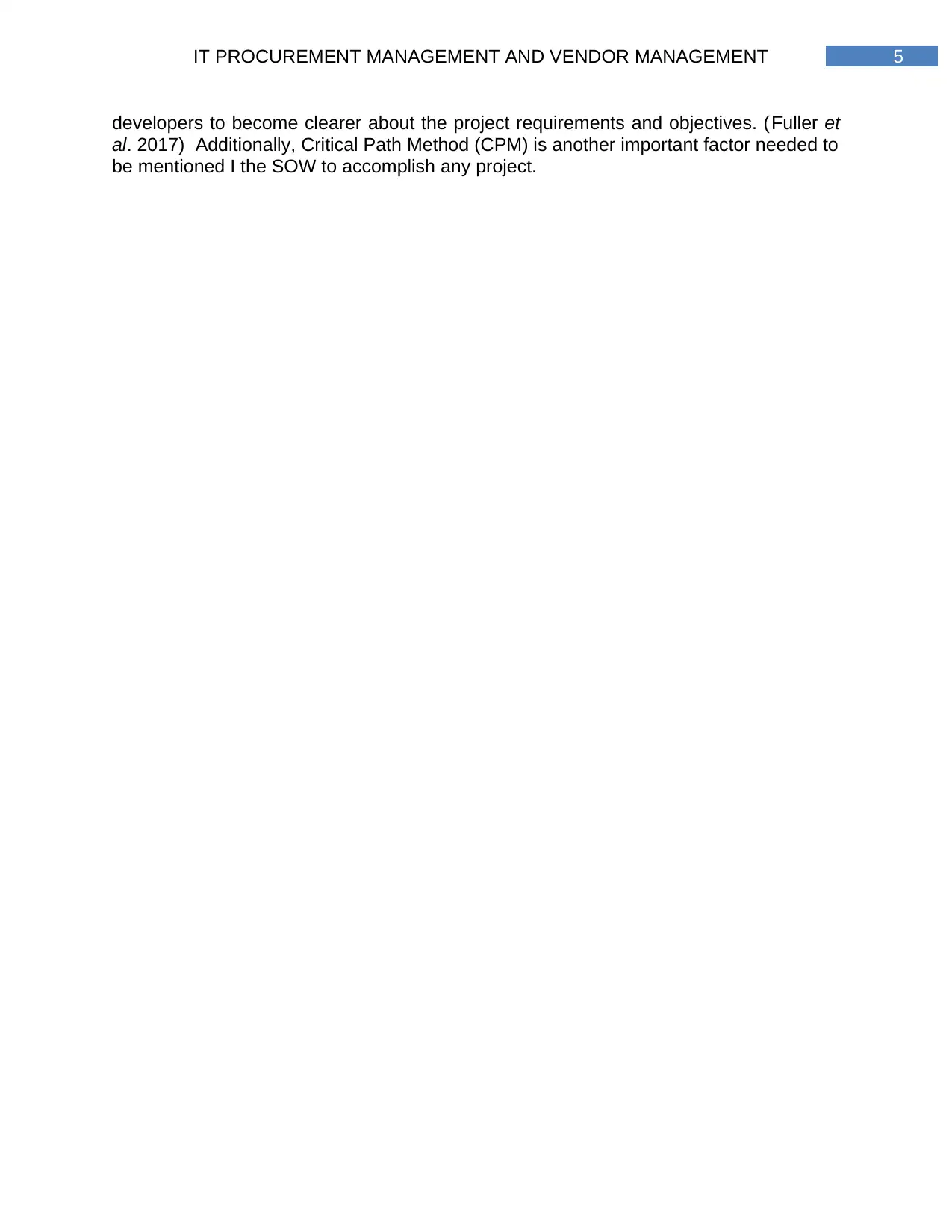
5IT PROCUREMENT MANAGEMENT AND VENDOR MANAGEMENT
developers to become clearer about the project requirements and objectives. (Fuller et
al. 2017) Additionally, Critical Path Method (CPM) is another important factor needed to
be mentioned I the SOW to accomplish any project.
developers to become clearer about the project requirements and objectives. (Fuller et
al. 2017) Additionally, Critical Path Method (CPM) is another important factor needed to
be mentioned I the SOW to accomplish any project.
⊘ This is a preview!⊘
Do you want full access?
Subscribe today to unlock all pages.

Trusted by 1+ million students worldwide
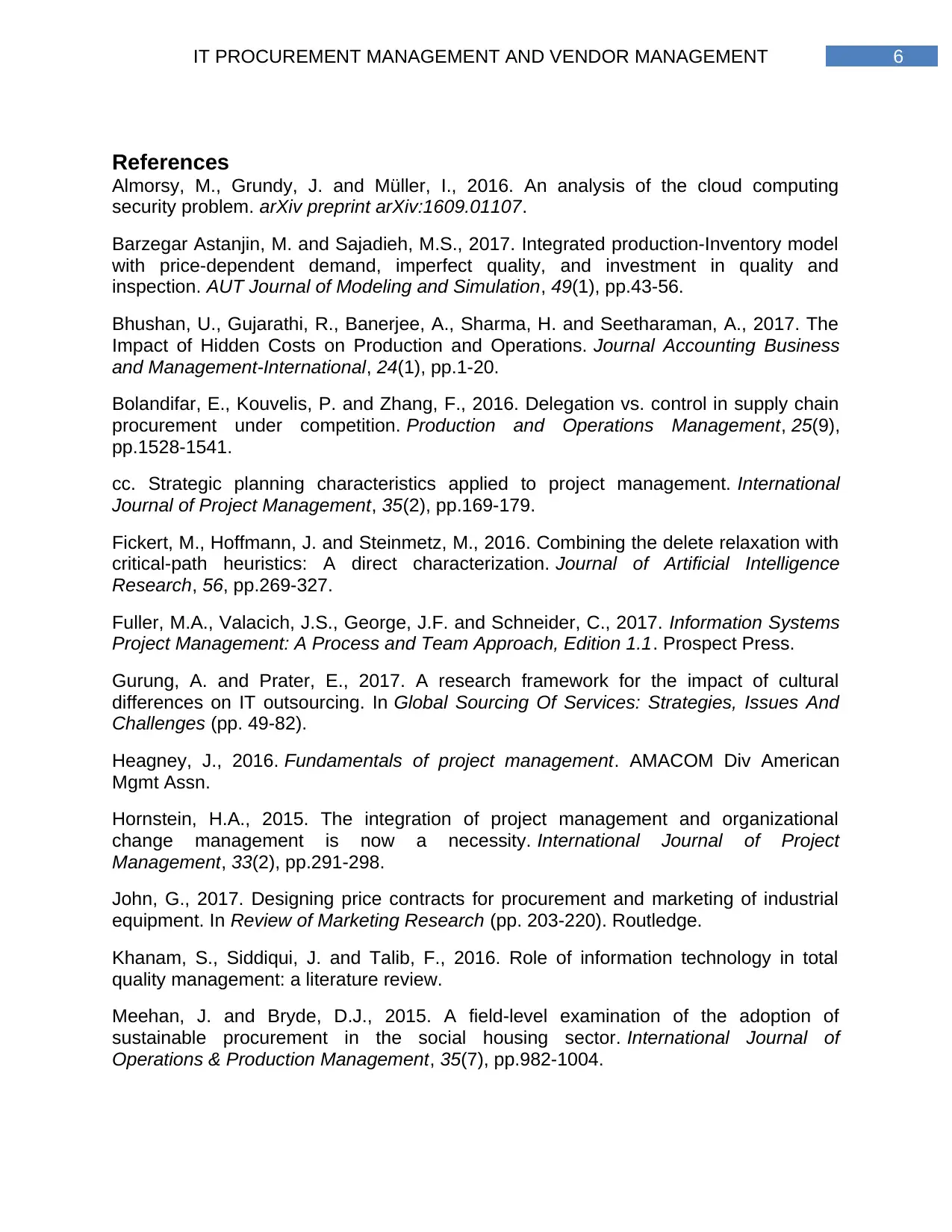
6IT PROCUREMENT MANAGEMENT AND VENDOR MANAGEMENT
References
Almorsy, M., Grundy, J. and Müller, I., 2016. An analysis of the cloud computing
security problem. arXiv preprint arXiv:1609.01107.
Barzegar Astanjin, M. and Sajadieh, M.S., 2017. Integrated production-Inventory model
with price-dependent demand, imperfect quality, and investment in quality and
inspection. AUT Journal of Modeling and Simulation, 49(1), pp.43-56.
Bhushan, U., Gujarathi, R., Banerjee, A., Sharma, H. and Seetharaman, A., 2017. The
Impact of Hidden Costs on Production and Operations. Journal Accounting Business
and Management-International, 24(1), pp.1-20.
Bolandifar, E., Kouvelis, P. and Zhang, F., 2016. Delegation vs. control in supply chain
procurement under competition. Production and Operations Management, 25(9),
pp.1528-1541.
cc. Strategic planning characteristics applied to project management. International
Journal of Project Management, 35(2), pp.169-179.
Fickert, M., Hoffmann, J. and Steinmetz, M., 2016. Combining the delete relaxation with
critical-path heuristics: A direct characterization. Journal of Artificial Intelligence
Research, 56, pp.269-327.
Fuller, M.A., Valacich, J.S., George, J.F. and Schneider, C., 2017. Information Systems
Project Management: A Process and Team Approach, Edition 1.1. Prospect Press.
Gurung, A. and Prater, E., 2017. A research framework for the impact of cultural
differences on IT outsourcing. In Global Sourcing Of Services: Strategies, Issues And
Challenges (pp. 49-82).
Heagney, J., 2016. Fundamentals of project management. AMACOM Div American
Mgmt Assn.
Hornstein, H.A., 2015. The integration of project management and organizational
change management is now a necessity. International Journal of Project
Management, 33(2), pp.291-298.
John, G., 2017. Designing price contracts for procurement and marketing of industrial
equipment. In Review of Marketing Research (pp. 203-220). Routledge.
Khanam, S., Siddiqui, J. and Talib, F., 2016. Role of information technology in total
quality management: a literature review.
Meehan, J. and Bryde, D.J., 2015. A field-level examination of the adoption of
sustainable procurement in the social housing sector. International Journal of
Operations & Production Management, 35(7), pp.982-1004.
References
Almorsy, M., Grundy, J. and Müller, I., 2016. An analysis of the cloud computing
security problem. arXiv preprint arXiv:1609.01107.
Barzegar Astanjin, M. and Sajadieh, M.S., 2017. Integrated production-Inventory model
with price-dependent demand, imperfect quality, and investment in quality and
inspection. AUT Journal of Modeling and Simulation, 49(1), pp.43-56.
Bhushan, U., Gujarathi, R., Banerjee, A., Sharma, H. and Seetharaman, A., 2017. The
Impact of Hidden Costs on Production and Operations. Journal Accounting Business
and Management-International, 24(1), pp.1-20.
Bolandifar, E., Kouvelis, P. and Zhang, F., 2016. Delegation vs. control in supply chain
procurement under competition. Production and Operations Management, 25(9),
pp.1528-1541.
cc. Strategic planning characteristics applied to project management. International
Journal of Project Management, 35(2), pp.169-179.
Fickert, M., Hoffmann, J. and Steinmetz, M., 2016. Combining the delete relaxation with
critical-path heuristics: A direct characterization. Journal of Artificial Intelligence
Research, 56, pp.269-327.
Fuller, M.A., Valacich, J.S., George, J.F. and Schneider, C., 2017. Information Systems
Project Management: A Process and Team Approach, Edition 1.1. Prospect Press.
Gurung, A. and Prater, E., 2017. A research framework for the impact of cultural
differences on IT outsourcing. In Global Sourcing Of Services: Strategies, Issues And
Challenges (pp. 49-82).
Heagney, J., 2016. Fundamentals of project management. AMACOM Div American
Mgmt Assn.
Hornstein, H.A., 2015. The integration of project management and organizational
change management is now a necessity. International Journal of Project
Management, 33(2), pp.291-298.
John, G., 2017. Designing price contracts for procurement and marketing of industrial
equipment. In Review of Marketing Research (pp. 203-220). Routledge.
Khanam, S., Siddiqui, J. and Talib, F., 2016. Role of information technology in total
quality management: a literature review.
Meehan, J. and Bryde, D.J., 2015. A field-level examination of the adoption of
sustainable procurement in the social housing sector. International Journal of
Operations & Production Management, 35(7), pp.982-1004.
Paraphrase This Document
Need a fresh take? Get an instant paraphrase of this document with our AI Paraphraser
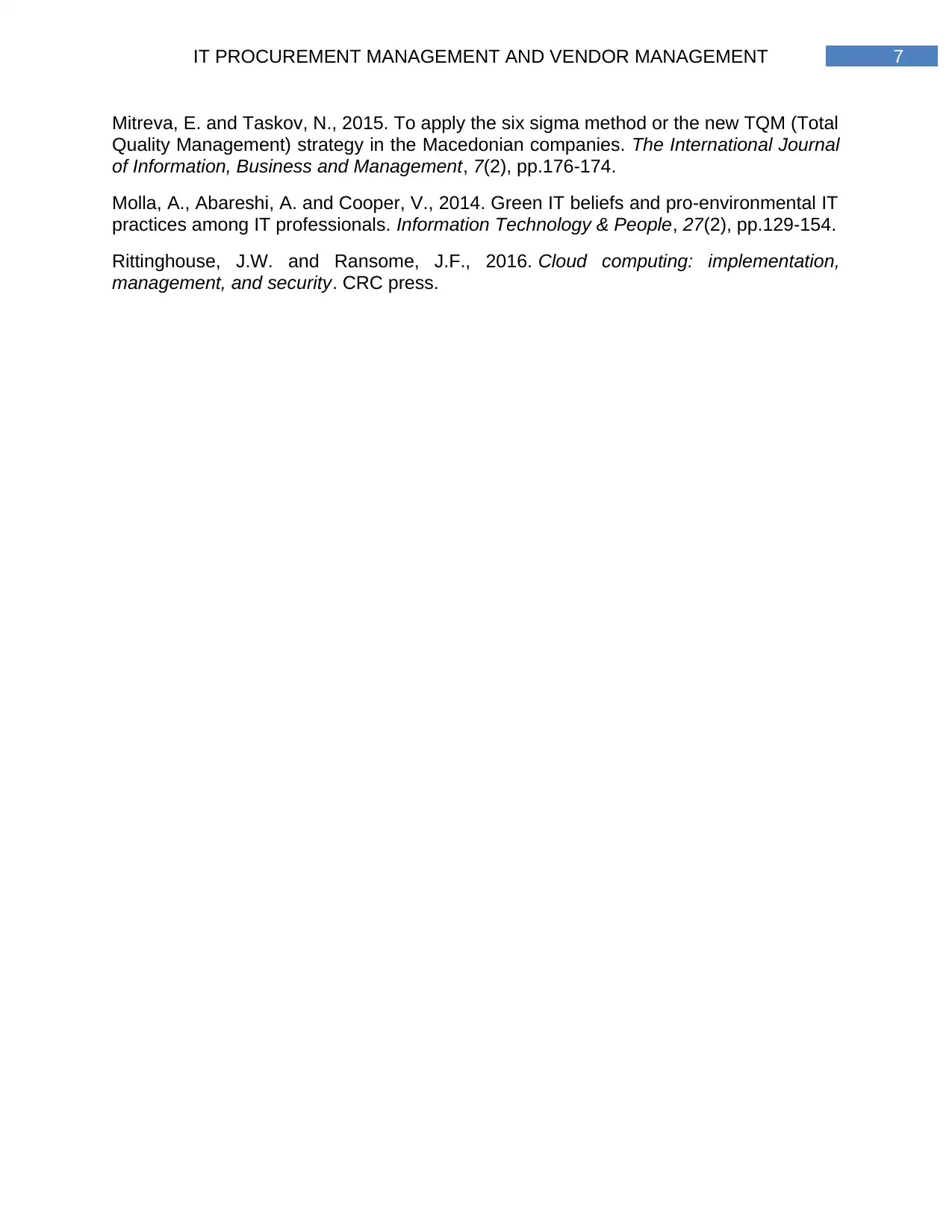
7IT PROCUREMENT MANAGEMENT AND VENDOR MANAGEMENT
Mitreva, E. and Taskov, N., 2015. To apply the six sigma method or the new TQM (Total
Quality Management) strategy in the Macedonian companies. The International Journal
of Information, Business and Management, 7(2), pp.176-174.
Molla, A., Abareshi, A. and Cooper, V., 2014. Green IT beliefs and pro-environmental IT
practices among IT professionals. Information Technology & People, 27(2), pp.129-154.
Rittinghouse, J.W. and Ransome, J.F., 2016. Cloud computing: implementation,
management, and security. CRC press.
Mitreva, E. and Taskov, N., 2015. To apply the six sigma method or the new TQM (Total
Quality Management) strategy in the Macedonian companies. The International Journal
of Information, Business and Management, 7(2), pp.176-174.
Molla, A., Abareshi, A. and Cooper, V., 2014. Green IT beliefs and pro-environmental IT
practices among IT professionals. Information Technology & People, 27(2), pp.129-154.
Rittinghouse, J.W. and Ransome, J.F., 2016. Cloud computing: implementation,
management, and security. CRC press.
1 out of 8
Related Documents
Your All-in-One AI-Powered Toolkit for Academic Success.
+13062052269
info@desklib.com
Available 24*7 on WhatsApp / Email
![[object Object]](/_next/static/media/star-bottom.7253800d.svg)
Unlock your academic potential
Copyright © 2020–2025 A2Z Services. All Rights Reserved. Developed and managed by ZUCOL.




